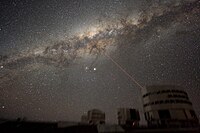
Photo from wikipedia
The Galactic Center region, including the nuclear disk, has until recently been largely avoided in chemical census studies because of extreme extinction and stellar crowding. Making use of the latest… Click to show full abstract
The Galactic Center region, including the nuclear disk, has until recently been largely avoided in chemical census studies because of extreme extinction and stellar crowding. Making use of the latest APOGEE data release (DR16), we are able for the first time to study cool AGB stars and supergiants in this region. The stellar parameters of five known AGB stars and one supergiant star (VR 5-7) show that their location is well above the tip of the RGB.We study metallicities of 157 M giants situated within 150 pc of the Galactic center from observations obtained by the APOGEE survey with reliable stellar parameters from the APOGEE/ASPCAP pipeline making use of the cool star grid down to 3200 K. Distances, interstellar extinction values, and radial velocities were checked to confirm that these stars are indeed situated in the Galactic Center region. We detect a clear bimodal structure in the metallicity distribution function, with a dominant metal-rich peak of [Fe/H] ~ +0.3 dex and a metal-poor peak around [Fe/H]= -0.5 dex, which is 0.2 dex poorer than Baade's Window. The alpha-elements Mg, Si, Ca, and O show a similar trend to the Galactic Bulge. The metal-poor component is enhanced in the alpha-elements, suggesting that this population could be associated with the classical bulge and a fast formation scenario. We find a clear signature of a rotating nuclear stellar disk and a significant fraction of high velocity stars with $\rm v_{gal} > 300\,km/s$; the metal-rich stars show a much higher rotation velocity ($\rm \sim 200\,km/s$) with respect to the metal-poor stars ($\rm \sim 140\,km/s$). The chemical abundances as well as the metallicity distribution function suggest that the nuclear stellar disc and the nuclear star cluster show distinct chemical signatures and might be formed differently.
Journal Title: Astronomy and Astrophysics
Year Published: 2020
Link to full text (if available)
Share on Social Media: Sign Up to like & get
recommendations!